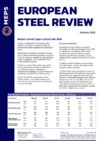European price decline dents green steel enquiries
European steel buyers' interest in green steel reduced after a price U-turn driven by end-users’ need to cut costs amid weak demand.
Automotive, energy and construction sectors continue to target net zero. Nonetheless, many respondents to MEPS’s March research suggest that stronger commitments are needed from end-users in order to ensure an uptick in green steel demand.
After the latest trading period assessed by MEPS delivered an earlier-than-expected decline in steel prices it became apparent that enquiries about green steel are declining. In the current period of heavily subdued demand, there is little scope for end-users to pass on to their customers the price premium it commands.
Green steelmakers’ energy focus
Investment in green steel production is growing as the European Commission’s target of making the steel industry a net zero carbon emitter by 2050 draws closer. New market entrants are seeking to establish production in regions with an abundance of fossil-free energy. This highlights the influence of renewable energy and Europe’s elevated electricity costs.
H2 Green Steel is set to establish its plant in a greenfield location with access to Swedish hydropower. Its potential has led to the signing of a definitive debt financing agreement worth EUR4.2bn to fund its green steel project. It has also raised EUR300m in equity and received a EUR250m grant from the EU’s Innovation Fund.
Last month MEPS reported that another start-up, Hydnum Steel, is planning the Iberian Peninsula’s first green steel plant after securing investments of more than EUR1.65bn. It will use locally generated renewable energy to produce the green hydrogen required for its DRI facility.
Steelmakers in the United Kingdom have raised concerns about the availability of cost-effective energy as the planned shift to EAF-based production is expected to almost double electricity consumption. The UK Government has pledged financial backing for the transition planned by Tata Steel at Port Talbot, South Wales, and British Steel in Scunthorpe and Teesside.
Race to renewables
However, the industry body UK Steel said in March that the UK Government had missed “a golden opportunity to ensure that electrified, green steelmaking can thrive in the UK” by abandoning plans to create a Green Power Pool. The system, adopted in France, Italy and Greece, aims to cut electricity costs by prioritising cheaper, renewable energy sources.
UK Steel argues that steelmakers in the country have paid electricity prices between 60% and 80% higher than in Germany and France during the past decade.
Under the European Commission’s Renewable Energy Directive, the EU has increased its 2030 renewable target from 32% to 42.5%, potentially paving the way to lower energy costs in the longer term. In Asia, Chinese authorities recently claimed that its non-fossil fuel power sources, which include nuclear power, now account for 50.9% of the country’s total installed energy generation capacity. Despite this, coal accounted for 56.2% of China’s energy consumption last year, versus 25.9% from non-fossil fuels.
Steelmakers' significant investments in transitioning to greener forms of steel production are considerable. Ultimately, the race to reform energy sectors is likely to determine how quickly green steel premiums fall and the material’s appeal widens.
- This content first appeared in the March edition of MEPS International's European Steel Review. The monthly report provides subscribers with steel prices, indices, market commentary and forecasts from across Europe.

Source:
European Steel Review
The MEPS European Steel Review is an informative, concise and easy-to-use monthly publication, offering unique professional insight into European carbon steel prices.
Go to productRequest a free publication





